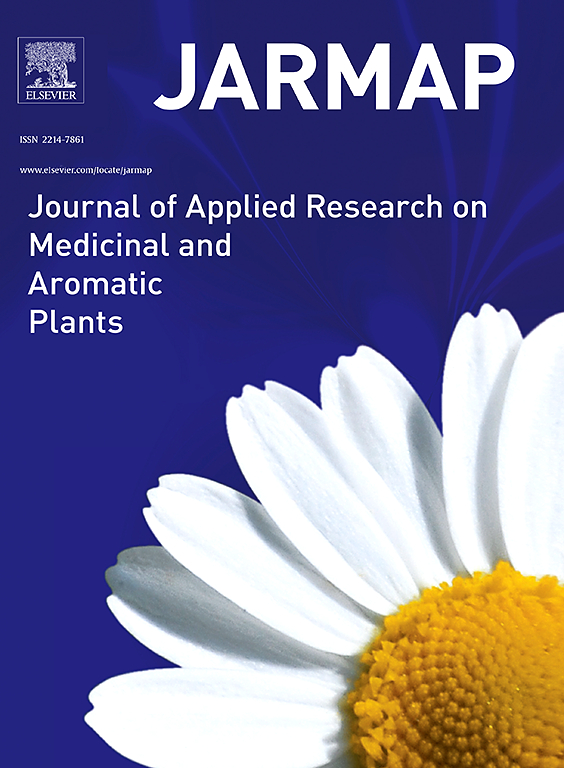Impact of extraction techniques on antioxidant properties and phenolic composition of extracts from different Satureja montana chemotypes cultivated in Serbia
IF 3.6
2区 农林科学
Q1 PLANT SCIENCES
Journal of Applied Research on Medicinal and Aromatic Plants
Pub Date : 2025-09-01
DOI:10.1016/j.jarmap.2025.100656
引用次数: 0
Abstract
Satureja montana (SM), an aromatic species of the Lamiaceae family, exhibits notable chemical polymorphism in its essential oil (EO) composition, primarily characterized by two dominant chemotypes: the carvacrol chemotype (carvacrol 50–70 %), predominant in Mediterranean regions, and the thymol chemotype (thymol 30–60 %), common in the Balkan Peninsula. A mixed carvacrol–thymol chemotype (both compounds 20–40 %) is frequently found in transitional zones between these areas. The chemotype-specific composition influences biological activity and sensory properties, guiding the selection of plant material for pharmaceutical, cosmetic, and food applications. However, it remains unclear whether such chemotypic variation extends to plant extracts, particularly those obtained using different extraction techniques. This study investigated how three extraction methods—maceration (M), ultrasound-assisted extraction (UAE), and microwave-assisted extraction (MAE)—affected the chemical composition, antioxidant activity, and yield of bioactive compounds in SM extracts derived from these chemotypes cultivated in South Banat, Serbia. High-Performance Liquid Chromatography (HPLC) analysis identified key phenolic compounds, including thymol, carvacrol, rosmarinic acid, rutin, and caffeic acid. MAE extracts exhibited the highest total polyphenol content (TPC) and total flavonoid content (TFC), with SM (T) extracted by MAE consistently showing the greatest concentrations of rosmarinic acid and rutin, along with superior antioxidant activity measured by ion exchange-based antioxidant assays (FRAP and CUPRAC). UAE was particularly efficient in extracting thymol and carvacrol, especially in the SM (T) chemotype, leading to higher activity in radical scavenging antioxidant assays (ABTS and DPPH). These results underscore the significant impact of both chemotype and extraction technique on the bioactive profile of SM extracts. Optimizing extraction based on chemotype is thus crucial for enhancing the therapeutic efficacy and industrial value of S. montana.
提取工艺对塞尔维亚不同化学型蒙大拿提取物抗氧化性能和酚类成分的影响
Satureja montana (SM)是Lamiaceae家族的一种芳香植物,其精油(EO)成分具有显著的化学多态性,主要具有两种优势化学型:地中海地区主要的carvacrol化学型(carvacrol 50-70 %)和巴尔干半岛常见的百里香酚化学型(thymol 30-60 %)。混合的香芹酚-百里香酚化学型(两种化合物20-40 %)经常在这些区域之间的过渡区发现。化学型特异性组成影响生物活性和感官特性,指导制药,化妆品和食品应用的植物材料的选择。然而,尚不清楚这种化学型变异是否延伸到植物提取物,特别是那些使用不同提取技术获得的植物提取物。本研究考察了浸渍法(M)、超声辅助提取法(UAE)和微波辅助提取法(MAE)三种提取方法对塞尔维亚南巴纳特种植的这些化学型SM提取物的化学成分、抗氧化活性和生物活性化合物产量的影响。高效液相色谱(HPLC)分析鉴定出主要酚类化合物,包括百里香酚、香芹酚、迷迭香酸、芦丁和咖啡酸。MAE提取物的总多酚(TPC)和总黄酮(TFC)含量最高,其中提取的SM (T)中迷迭香酸和芦丁的含量最高,并通过离子交换抗氧化试验(FRAP和CUPRAC)测定其抗氧化活性。阿联酋在提取百里香酚和香芹酚方面特别有效,特别是在SM (T)化学型中,导致自由基清除抗氧化试验(ABTS和DPPH)具有更高的活性。这些结果强调了化学型和提取技术对SM提取物生物活性的显著影响。因此,基于化学型优化提取对提高蒙大拿的疗效和工业价值至关重要。
本文章由计算机程序翻译,如有差异,请以英文原文为准。
求助全文
约1分钟内获得全文
求助全文
来源期刊

Journal of Applied Research on Medicinal and Aromatic Plants
Pharmacology, Toxicology and Pharmaceutics-Drug Discovery
CiteScore
6.40
自引率
7.70%
发文量
80
审稿时长
41 days
期刊介绍:
JARMAP is a peer reviewed and multidisciplinary communication platform, covering all aspects of the raw material supply chain of medicinal and aromatic plants. JARMAP aims to improve production of tailor made commodities by addressing the various requirements of manufacturers of herbal medicines, herbal teas, seasoning herbs, food and feed supplements and cosmetics. JARMAP covers research on genetic resources, breeding, wild-collection, domestication, propagation, cultivation, phytopathology and plant protection, mechanization, conservation, processing, quality assurance, analytics and economics. JARMAP publishes reviews, original research articles and short communications related to research.
 求助内容:
求助内容: 应助结果提醒方式:
应助结果提醒方式:


